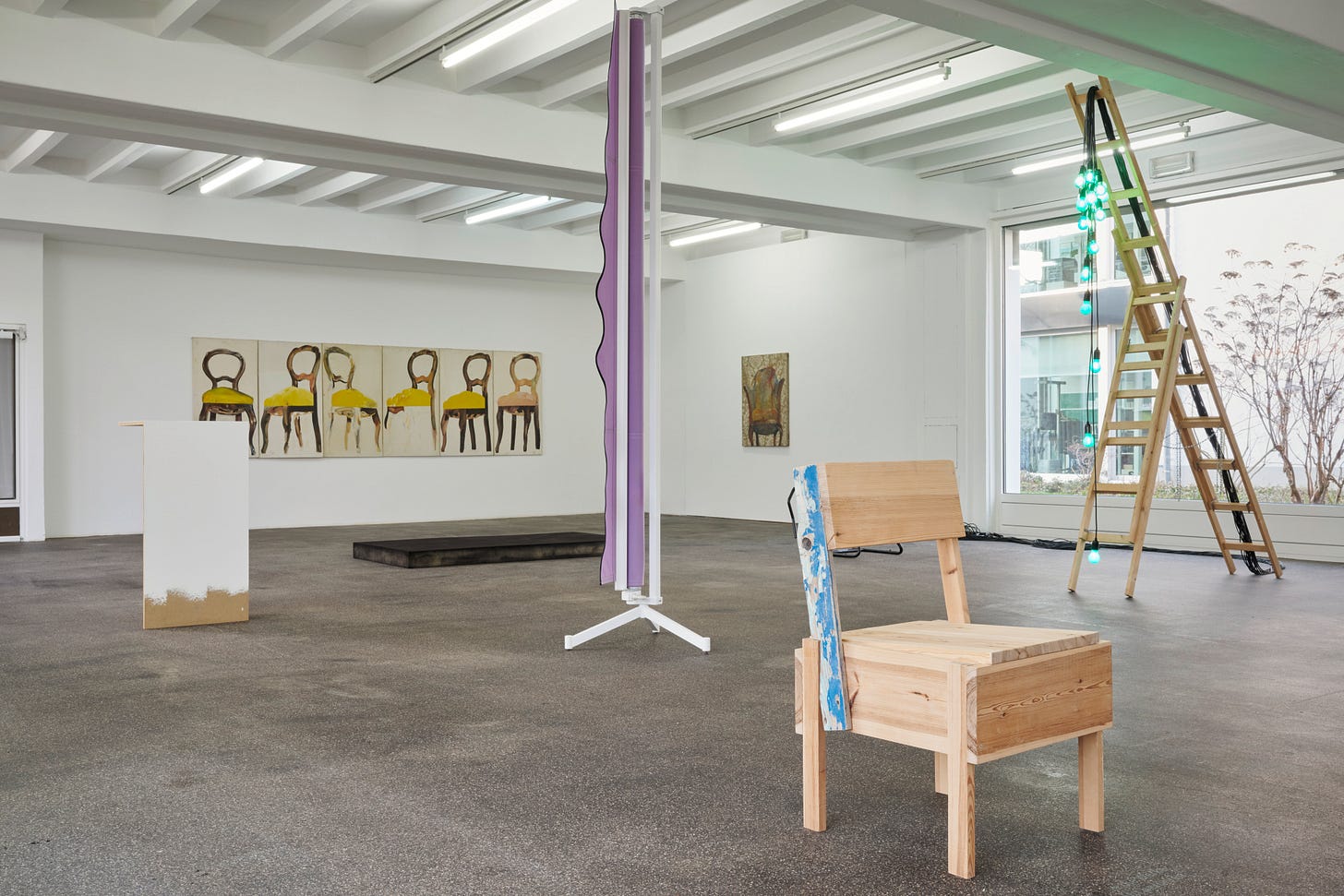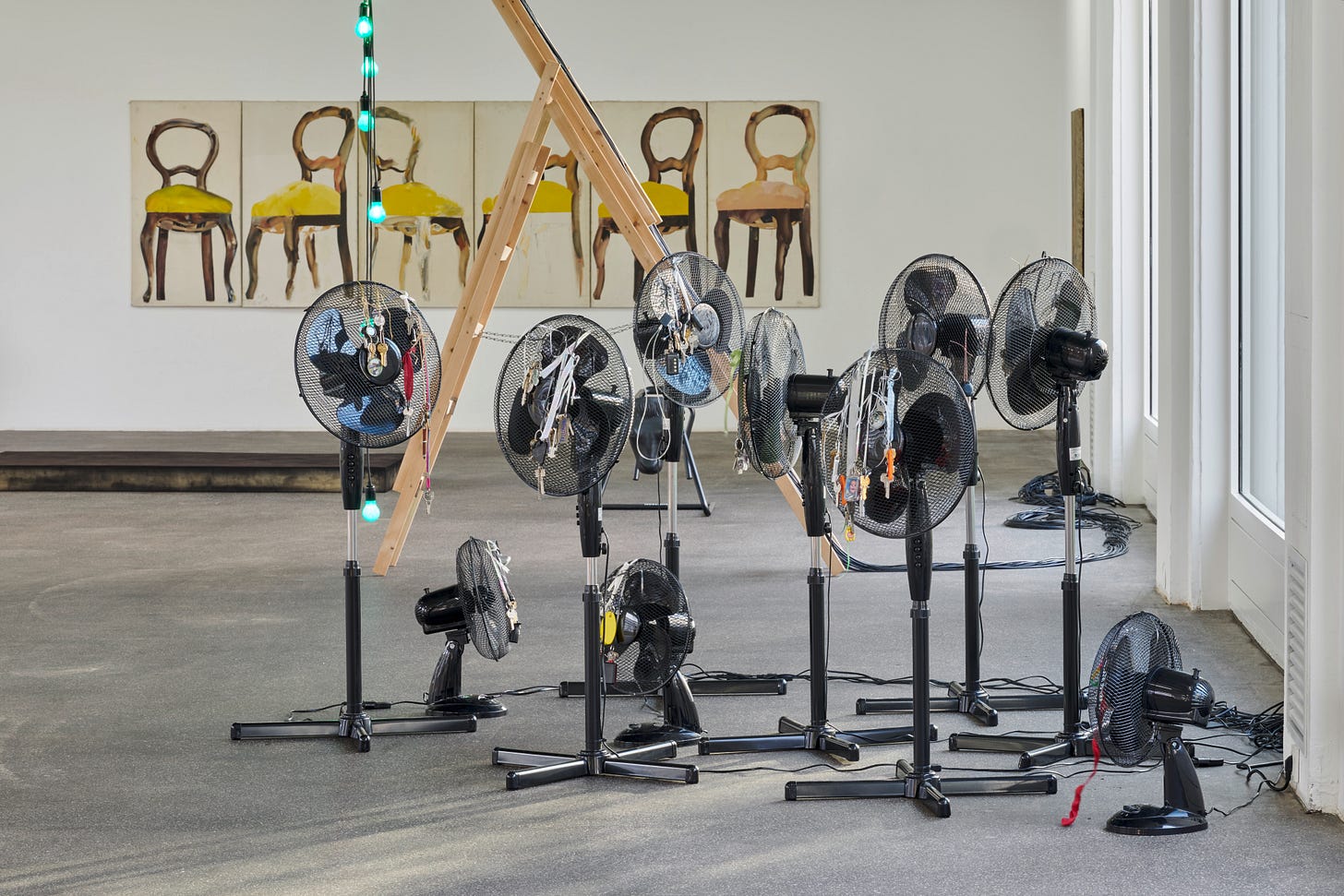SUPERMÖBEL at Kölnischer Kunstverein: Is Repetition Really Key?
Director Valérie Knoll (Gen X, Swiss) brought together eighteen artists on the theme of furniture...again?
Doing too much and too little at once
You know how cows are ruminants, right? They literally throw up what they digested to chew it for another round. While this biological process has its place within the animal kingdom, I don’t really catch on to why it’s applied at the Kölnischer Kunstverein. The show is basically a remake of Hoi Köln Teil 1, the first out of the three inaugurational shows curated by the new director Valérie Knoll (Gen X, Swiss) back in 2023. That show series did center painting, but the idea of “moving in” as a new director was an integral part of the concept. We had a whole lot of furniture there, we have a whole lot of furniture here. Like okay, we already had a decent housewarming. Why are we back at it again?
Let’s get the exhibition booklet. The first paragraph is about the politics of furniture (we’ll keep that in mind and return later). Paragraph two then elaborates on how Valérie conceived this exhibition for a friend — be it a real person or just a symbolic anecdote, idk — “who, deep in his unconscious, refuses to live the way we live”… Excuse me Ma’am, but: Huh???
Main hall: The first work is a minty-grey empty donkey shelf by Nuri Koerfer (Millennial, Swiss). Coming from the entrance, the piece is positioned slightly to the left, but dominant enough to stop me in my tracks. Valérie already used this very same curatorial strategy back at Hoi Köln Teil 1 with a red velvet curtain by Emil Michael Klein (Millennial, German) and at Hoi Köln Teil 2 with Lucie Stahl’s (Gen X, German) Rear View (2023).
Another familiar throwback is Joseph Zehrer’s (Baby Boomer, German) Lichtskulptur türkisgrün (1993/2024), consisting of turquoise green lightbulbs attached to a wooden ladder. Positioned close to the windows facing the courtyard, the piece is almost at the exact same spot as Kaspar Müller’s (Millennial, Swiss) untitled lamp at Hoi Köln Teil 1. I don’t know if those repetitions are a conscious déjà-vu evoking moment or whether it’s poor imagination. Like maybe it’s some curatorial inside joke that I don’t understand, but I don’t see the vision in repeating similar visuals over and over again.
Iris Touliatou’s (Millennial, Greek) emotional infinity (the sound of them coming back amplified and looped) (2016/2024) triggered my fight or flight: 10 rotating fans with house keys attached. I’m not even joking when I say that every fifth student at the HfbK Hamburg Rundgang in February did something with house keys… I don’t see how contrasting fans with keys would be interesting. Like yeah, they dangle a bit and make some noise…now what?
Michael Beutler (Gen X, German) usually does some pretty dope immersive architectural work using paper or other fragile materials. Here, though, it’s a 16-meter-long rug. A rug? On the floor? Groundbreaking. Don’t give them ideas or they’ll come up with putting it on the wall — and that would be really something new, right?
Holm von Czettritz’s (1939-2017, German) six untitled chair paintings from around 1970 hang on the wall in the veeery back of the room. Only the third piece from the left intrigued me aesthetically: The yellow oil paint must have cracked open over the decades, now imitating the worn leather seat it depicts.
This exhibition appears to suffer from the same condition as many held within a tight space — I like to call it “the corridor panic”: It’s why many curators dislike working with the endless Arsenale halls at the Venice Biennale, it’s the struggle I saw in the basement presenting the contemporary collection at Kunstmuseum Stuttgart and what I see here as well. As soon as we leave the regular white cube, the curatorial concepts turn out increasingly shaky…
Whitewashing The Politics of Furniture
Let’s return to the exhibition booklet. What I read made matters worse. So the first page is about how “Furnishing a home is not inherently political” but at the same time, furnishing “explain[s] even more than sex why the private is political.” True. I believe you can’t be unpolitical. Just like you can’t not communicate and can’t not make aesthetic decisions. All of those are intertwined. And yet, Valérie presents her argument as an individual choice: “How I have chosen my furniture says a lot about me – as does my choice of all products. I am presenting myself, and my position on the social ladder becomes clear, with all the advantages and disadvantages that entails.” But choosing furniture isn’t a personal decision: It’s shaped by broader values and ideologies.
In the second sentence, Valérie states “People don’t just want to eat off the floor, so they set up a table and pull up some chairs, to give the matter a certain form.” Let me stop you right there. In Germany, we say “Wer A sagt, muss such B sagen”, so please say the quiet part out loud: Cause who exactly is “people” in your statement?
Furniture culture varies according to the geographical context and, yes, sometimes people sit on the floor. And sometimes, people sleep on floor mats and not in beds. The Euroamerican standard of home furnishing doesn’t apply all around the world. You’re saying “Furnishing a home is not inherently political”, so Bauhaus isn’t political? Le Corbusier (1887-1965, Swiss-French) designing kitchens and furniture to fit an average man (!!!) isn’t political? Let me get more specific: The peacock chair being historically manufactured by Filipino prisoners and bought by White socialites as symbols of colonialist supremacy isn’t political? And what about the Black Power movement reclaiming the chair for the oppressed?
Let’s get contemporary: Millennial greige home design and Scandi obsession lacking any color and ornament mimicking the ideology of Adolf Loos's “Ornament and Crime” (1913) isn’t political? What about the Dutch lack of curtains to date which, some argue, might stem from Calvinist values like honesty? Shall I go on? Babes, I’m just scratching the surface here.
How can you even argue that “Furnishing a home is not inherently political” or that it is, but keep it on a shallow level? You could have started a conversation about how unaware people might be of the politics in their furnishing. Instead, the lukewarm combination of a personal selection for a friend and a half-earnest political debate gives us nothing of substance. Also: doing a show with furniture “as sombre [sic] and complex as the reality of Germany” and NOT including any of Jody Korbach’s (Millennial, German) furniture installations is a VIOLATION at this point.
Repetitive Rhetorics
The show felt also bland to me because most objects displayed were pretty much still functional. One of the very few exceptions that wonderfully discarded function for an aesthetic experience was Nicole Wermers’s (Gen X, German) Vertical Awning (2016) series: She makes a tool for providing shadow useless in two ways: She rolls the awning up, and she does so vertically. Five of these sculptural pieces line the room diagonally. Every awning is striped in different colors, although they all share wavy fringes. A cheeky nod to Daniel Buren (Silent Generation, French), perhaps?
Another favorite: Downstairs, Rosemarie Trockel (Baby Boomer, German), Thea Djordjadze (Gen X, Georgian-German), and Gerda Scheepers (Gen X, South-African) present their joint work Automne/Frottée 06/07 (2006): A light greyish blue wooden bed. On top, BOOM! — a metallic car roof box. The surreal tension between the cozy bed and the suggested force of the heavy box is unbearable. The car roof box appears abstract, a coffin rather than a practical container for family road trips. There’s nobody in the bed except for a picture of a disheveled person tucked into the sheets. Have they woken up from the fallen box that almost crushed them?
Those were great works. But the rest? I felt like everything had already been in that building at some point. The artistic approaches feel the same…. Dozie Kanu (Millennial, US-American) was even part of all three Hoi Köln shows and Supermöbel. Come on, artists aren’t raw materials: You don’t have to recycle them endlessly for sustainability. It takes away the space to show more newcomers. It’s one thing when you’re a collection and have to work with what you got in storage. But isn’t the beauty of art associations that they get to be daring? They aren’t tied to a collection, they aren’t tied to donors or communal picky attitudes. They get to present young, fresh perspectives to a larger public while offering institutional recognition. Regarding the group shows here, I feel like it’s always more or less established middle-aged artists that get remixed over and over and over and over and over again.
An artist friend recently shared how he’s annoyed with Cologne’s self-sufficient attitude. There’s no avant-garde drive in this city, everybody is content with the glorious past days, he said. And looking at this exhibition, It’s hard to disagree. In an interview for Kunstforum’s issue on art associations, Valérie stated that art associations are places for experiments. In this show, I only hear a record player endlessly scratching the same disc. What a pity that they didn’t have one.
Supermöbel, through May 5, 2025, at Kölnischer Kunstverein.
Kölnischer Kunstverein
Hahnenstraße 6
50667 Cologne
Website
Instagram: @koelnischerkunstverein
Anyway, subscribe and share, pookies!
See you soon!!!
Jennifer
The Gen Z Art Critic








